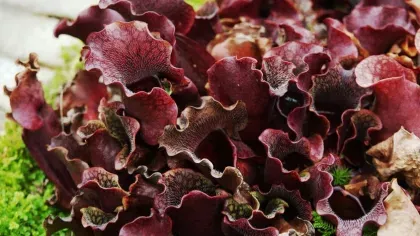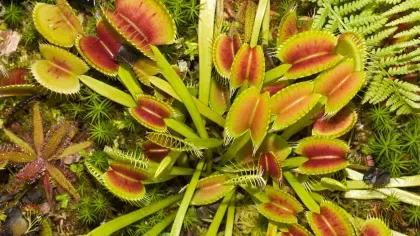
California pitcher plant
On this page
In the riversides and bogs of northern California and southern Oregon, a hungry plant waits between the rocks for its next arthropod meal.
The California pitcher plant is also known as the cobra lily, a moniker it gets thanks to its large hood and fang-like leaves which differentiate them from many other pitcher plants.
It has a number of adaptations, including false exits and slippery walls. The plant is able to capture and digest insects to make up for the lack of nitrogen it receives from the soil.
Challenging to cultivate, numbers of the California pitcher plant are falling due to changes in land use and overcollection by plant hunters.
Similar to the Venus flytrap, the California pitcher plant can survive being burnt by wildfires, by regenerating from its roots.
Plant description
The California pitcher plant has tall green hollow leaves, known as pitchers, that grow to an average of 50cm, although can grow to almost 1m in the right conditions. These pitchers are full of water pumped in by the plant that contains enzymes to digest potential prey. The top of the leaf is covered by a ‘hood’ that has numerous translucent windows. Two red-green leaf-like projections that produce a sugary nectar grow from the end of the hood.
Each plant will grow a single bell-shaped flower, around 6cm across on a tall, thin stem. The flower has five green outer sepals, and five red-green inner petals.
Read the scientific profile for the California pitcher plant




Plant uses
Cultural
California pitcher plants are popular as houseplants, although are notoriously difficult to cultivate.
Did you know?
What exactly pollinates the California pitcher plant is unknown, although both bees and spiders have been observed visiting the flowers.
The genus Darlingtonia is named after American botanist, William Darlington.
Where in the world?

Swamps in mountain areas of northern California and southern Oregon. Redwood and red fir forests up to 2,000m above sea level.
Find it in our gardens
Kew Gardens
A botanic garden in southwest London with the world’s most diverse living plant collection.
Location
Princess of Wales Conservatory
View map of Kew GardensBest time to see
More about this plant
Other plants

Giant redwood
Sequoiadendron giganteum

Purple pitcher plant
Sarracenia purpurea

Venus flytrap
Dionaea muscipula

 (1).jpg.webp?itok=23GeDj7g)
.jpg.webp?itok=OEXY4ft-)